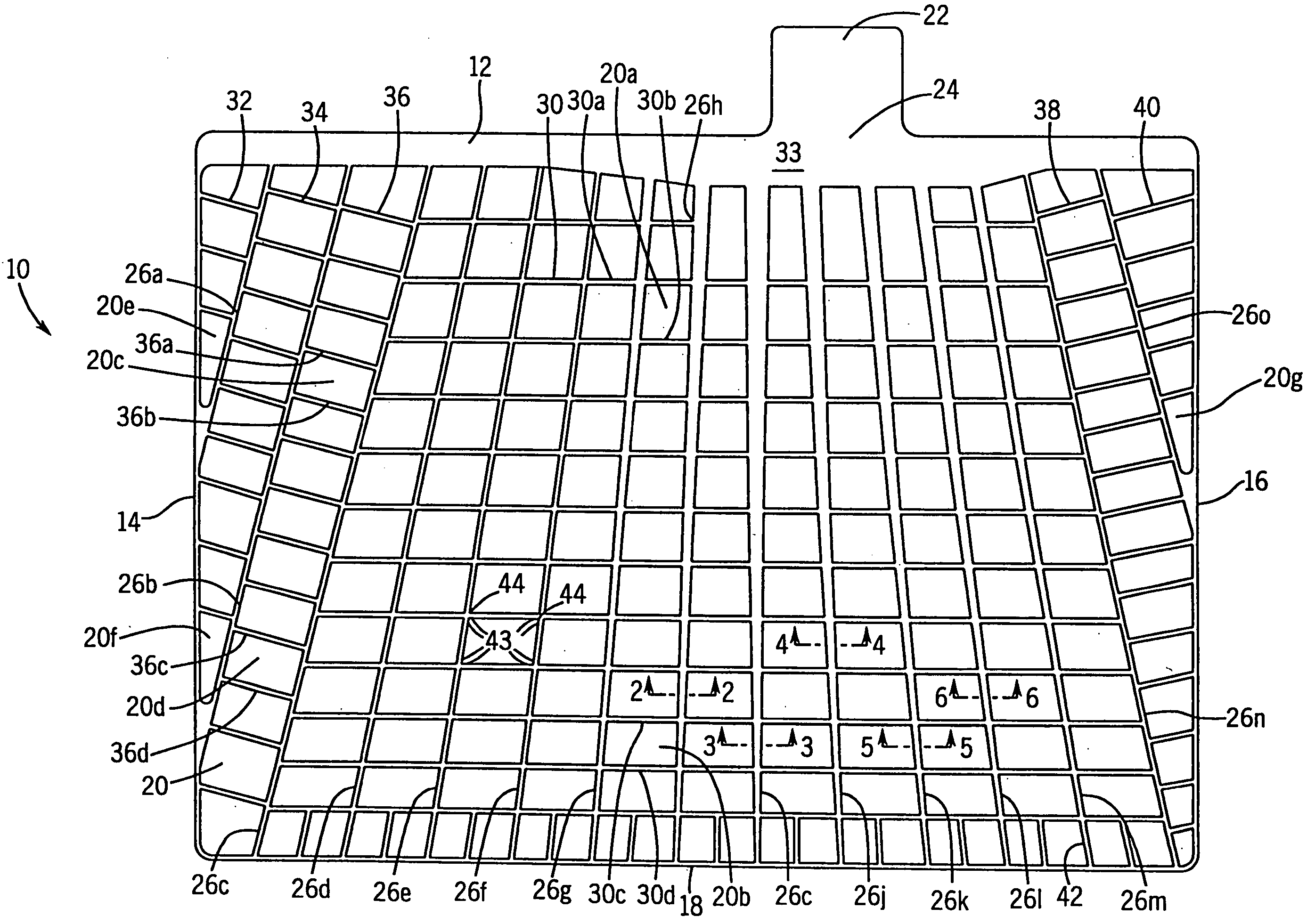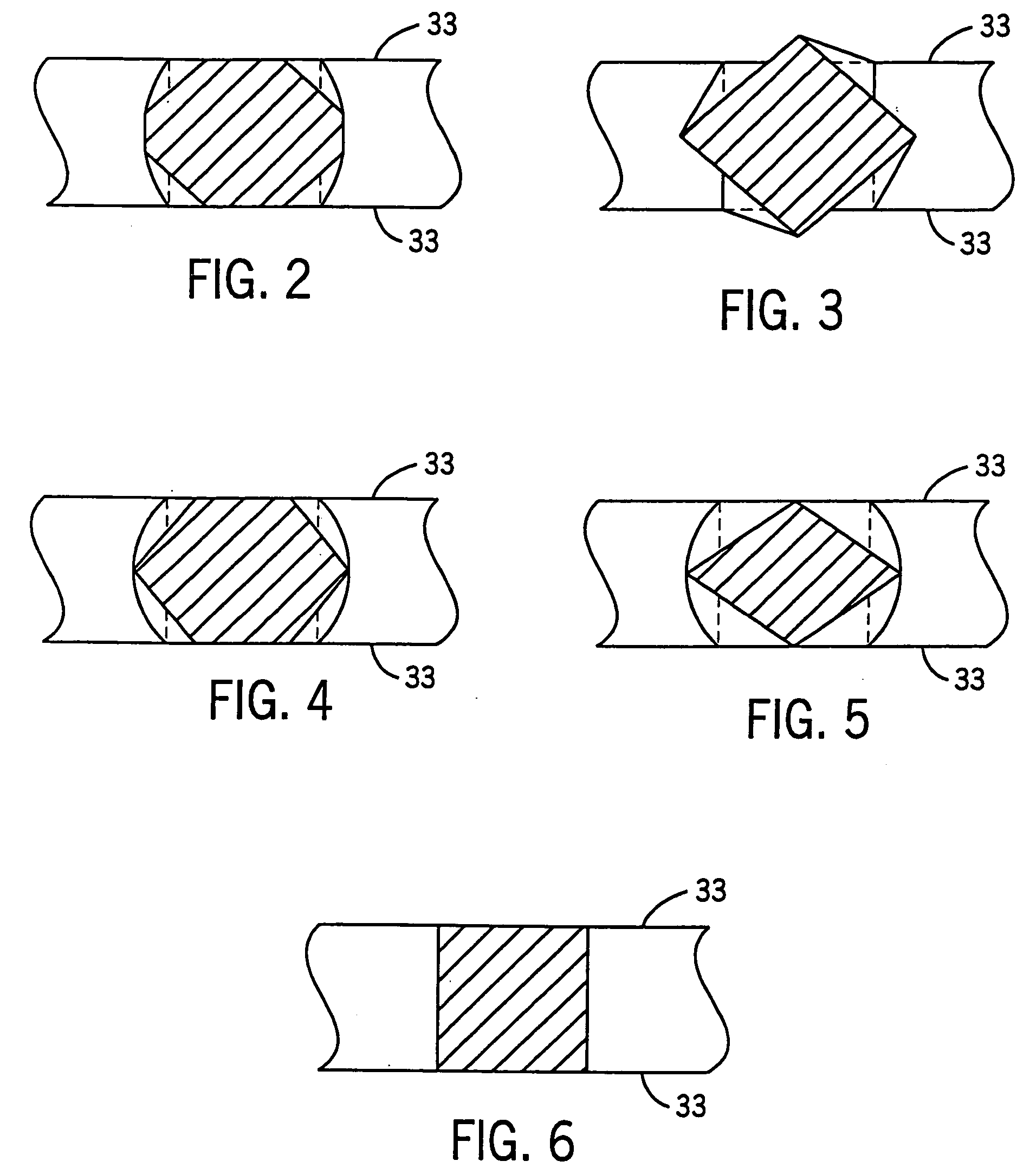Method for making battery plates
a battery plate and plate body technology, applied in the field of battery plate modification, can solve the problems of lead-acid batteries failing in service, lead-acid batteries having lead-antimony grids that require periodic maintenance, water loss caused by gassing,
- Summary
- Abstract
- Description
- Claims
- Application Information
AI Technical Summary
Benefits of technology
Problems solved by technology
Method used
Image
Examples
example 1
[0072] A continuous strip was prepared from a lead-alloy having the following composition: 0.0425 wt. % calcium, 0.925 wt. % tin, 0.013 wt. % aluminum, 0.0125 wt. % silver and balance lead. A series of interconnected battery grid shapes were then formed in the strip in a progressive punching operation, i.e., features were added to the battery grid through several punching operations. The battery grid wire sections of the strip were then processed in a coining station to coin the grid wires so that the grid wires had a cross-section similar to the grid wire cross-sections 90c in FIG. 4. The interconnected battery grids were then divided into individual grids. The grids were then pasted with a conventional battery paste and formed into battery cells. The battery cells were then cycled in accordance with the SAE J240 life test procedure at a temperature of 75° C. (167° F.) to measure the service life.
example 2
[0073] A continuous strip was prepared from a lead-alloy having the following composition: 0.0425 wt. % calcium, 0.925 wt. % tin, 0.013 wt. % aluminum, 0.0125 wt. % silver and balance lead. A series of interconnected battery grid shapes were then formed in the strip in a progressive punching operation, i.e., features were added to the battery grid through several punching operations. The battery grid wire sections of the strip were then processed in a coining station to coin the grid wires so that the grid wires had a cross-section similar to the grid wire cross-sections 90c in FIG. 4. The interconnected battery grids were then divided into individual grids. The grids were then hand dipped into a pot of molten 94 wt. % lead—6 wt. % tin coating alloy. The grids were dipped slowly into the melt until they bottomed out in the pot and then slowly withdrawn at the same rate for a total immersion time of about 2 seconds. The coating was uniform with no excess buildup on the grid wires or ...
example 3
[0074] A continuous strip was prepared from a lead-alloy having the following composition: 0.0425 wt. % calcium, 0.925 wt. % tin, 0.013 wt. % aluminum, 0.0125 wt. % silver and balance lead. A series of interconnected battery grid shapes were then formed in the strip in a progressive punching operation, i.e., features were added to the battery grid through several punching operations. The battery grid wire sections of the strip were then processed in a coining station to coin the grid wires so that the grid wires had a cross-section similar to the grid wire cross-sections 90c in FIG. 4. The interconnected battery grids were then divided into individual grids. The grids were then hand dipped into a pot of molten 94 wt.% lead—3 wt. % tin—3 wt. % antimony coating alloy. The grids were dipped slowly into the melt until they bottomed out in the pot and then slowly withdrawn at the same rate for a total immersion time of about 2 seconds. The coating was uniform with no excess buildup on th...
PUM
| Property | Measurement | Unit |
|---|---|---|
| weight percent | aaaaa | aaaaa |
| weight percent | aaaaa | aaaaa |
| weight percent | aaaaa | aaaaa |
Abstract
Description
Claims
Application Information
 Login to View More
Login to View More - R&D
- Intellectual Property
- Life Sciences
- Materials
- Tech Scout
- Unparalleled Data Quality
- Higher Quality Content
- 60% Fewer Hallucinations
Browse by: Latest US Patents, China's latest patents, Technical Efficacy Thesaurus, Application Domain, Technology Topic, Popular Technical Reports.
© 2025 PatSnap. All rights reserved.Legal|Privacy policy|Modern Slavery Act Transparency Statement|Sitemap|About US| Contact US: help@patsnap.com



